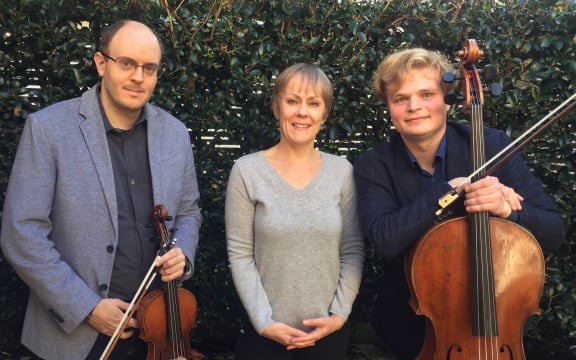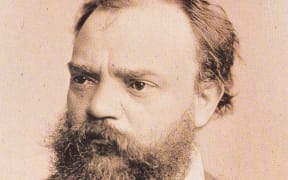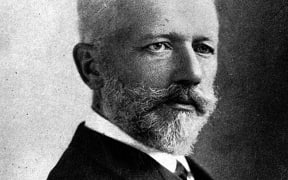
Levansa Trio: Andrew Beer (vln), Sarah Watkins (pno), Lev Sivkov (cello), Photo: Supplied Wellington Chamber Music Trust
In 2019 the talented young Russian cellist Lev Sivkov performed with orchestras around the country. To take advantage of that tour, a special trio was formed to put on a series of chamber concerts. Violinist and concertmaster of the Auckland Phil, Andrew Beer, and former NZTrio pianist Sarah Watkins formed the Levansa Trio with Lev Sivkov, the name an amalgam of their surnames.
Two years later, the international award winning cellist and principal cellist of the Royal Danish Opera and Zurich Opera was back, and the Levansa Trio reformed for another tour.

Antonin Dvorak in 1882 Photo: Public Domain via Wikimedia Commons
Dvořák’s second piano trio was written four months after his first daughter's death shortly after childbirth in 1875. While the trio is regarded as a memorial to her, the music itself is not elegiac, though it is set in the key of g minor, the same key as the one his teacher Bedřich Smetana had written decades earlier at the death of his daughter.
While the music does not directly reference this turbulent time, it is a full scale work in the legacy of the great chamber music composers Beethoven, Schubert, and Mendelssohn, as well as heavily influenced by Brahms. Despite the Germanic tradition, Dvořák infuses the work Czech folk-like melodies, and the trio itself kicked off a period overflowing with creativity from the composer, often with feeling of nostalgia and sorrow.

Claire Cowan Photo: Supplied
Inspired by a bird's ability to see in the ultra-violet spectrum which contains millions more colours than we can perceive with our eyes, allowing them to navigate by this vibrant world beyond our sight. Cowan wrote this during a period of travel and she intends it to convey the feeling of observing the world from above.
Russian Georgy Sviridov was born 1915 in Fatezh, a town 500 km south of Moscow and passed away in 1998. He was a pupil of Dmitry Shostakovich at the Leningrad Conservatory, and if you’re familiar with Shostakovich’s 2nd Piano Trio, or any of his music in fact, you’ll hear that strong influence in Sviridov’s in this piece.
The younger composer was awarded the Stalin prize in 1946 for this piano trio. It’s a powerful work with ambitious scale which Sviridov wrote during the lengthy siege of Leningrad by Nazi Germany.
The trio takes us on a broad emotional journey, from somber nostalgia in the opening, to a dance macabre in the scherzo that will be familiar to fans of Shostakovich. The finale is called ‘Idyll’, with its playful pastoral folk-feel, suggesting a return to peace which seems robbed by the anguished quiet ending, reminding us of the tragedy of war.

Photo: Public Domain
Tchaikovsky composed his only piano trio to honour his longtime friend and mentor, pianist Nikolai Rubinstein…the same man who harshly criticised his piano concerto. But that cloud over their friendship was a temporary one, and Tchaikovsky was deeply upset to hear of Rubinstein’s untimely passing in Paris at the age of 45, and gave this trio the subtitle ‘to the memory of a great artist’.
It was actually Tchaikovsky’s patron, Nadezhda von Meck, who first planted the idea of composing a work for her resident trio the year before in 1880. The form that had been a mainstay of composers like Haydn, Mozart, and Beethoven was not popular in Russia, and Tchaikovsky put von Meck off by claiming the combination of strings and piano had ‘no tonal blend’, and that the piano could only be used in three scenarios: “alone, in contest with the orchestra, or as accompaniment in the background of a picture”.
He may have also resisted the idea out of jealousy of von Meck’s star house pianist, who he may have seen as a rival for her support, the teenage Claude Debussy.
But with the idea planted, Tchaikovsky imagined a virtuosic piano work with the scale of a symphony. The piece opens with a Pezzo elegiaco, a brooding if standard opening movement, though with an unusual funeral march at the close. Then we have the second movement, which takes up the majority of the trio as a massive set of theme of variations that builds to its virtuosic heights, giving the piano many opportunities to dazzle, before a sudden return to the opening elegy, given far more weight, leaving us with the funeral march and reminding us of the loss of the great artist.

